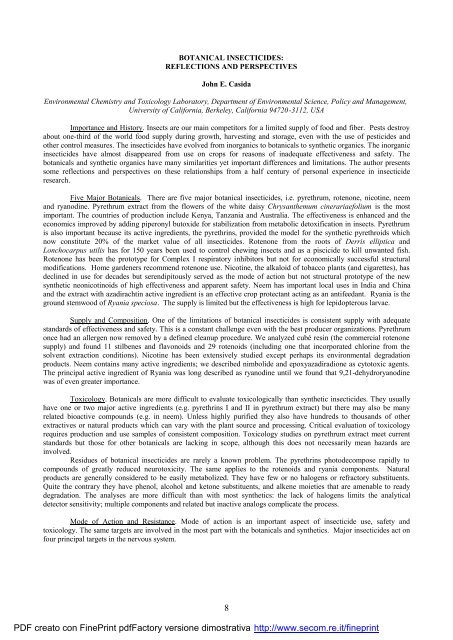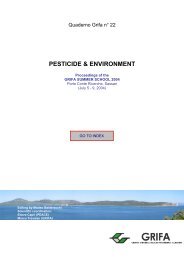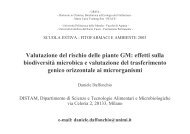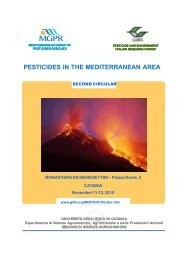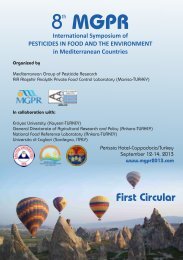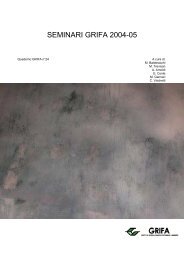International Congress BIOLOGICAL PRODUCTS - Gruppo di ...
International Congress BIOLOGICAL PRODUCTS - Gruppo di ...
International Congress BIOLOGICAL PRODUCTS - Gruppo di ...
Create successful ePaper yourself
Turn your PDF publications into a flip-book with our unique Google optimized e-Paper software.
BOTANICAL INSECTICIDES:<br />
REFLECTIONS AND PERSPECTIVES<br />
John E. Casida<br />
Environmental Chemistry and Toxicology Laboratory, Department of Environmental Science, Policy and Management,<br />
University of California, Berkeley, California 94720-3112, USA<br />
Importance and History. Insects are our main competitors for a limited supply of food and fiber. Pests destroy<br />
about one-third of the world food supply during growth, harvesting and storage, even with the use of pesticides and<br />
other control measures. The insecticides have evolved from inorganics to botanicals to synthetic organics. The inorganic<br />
insecticides have almost <strong>di</strong>sappeared from use on crops for reasons of inadequate effectiveness and safety. The<br />
botanicals and synthetic organics have many similarities yet important <strong>di</strong>fferences and limitations. The author presents<br />
some reflections and perspectives on these relationships from a half century of personal experience in insecticide<br />
research.<br />
Five Major Botanicals. There are five major botanical insecticides, i.e. pyrethrum, rotenone, nicotine, neem<br />
and ryano<strong>di</strong>ne. Pyrethrum extract from the flowers of the white daisy Chrysanthemum cinerariaefolium is the most<br />
important. The countries of production include Kenya, Tanzania and Australia. The effectiveness is enhanced and the<br />
economics improved by ad<strong>di</strong>ng piperonyl butoxide for stabilization from metabolic detoxification in insects. Pyrethrum<br />
is also important because its active ingre<strong>di</strong>ents, the pyrethrins, provided the model for the synthetic pyrethroids which<br />
now constitute 20% of the market value of all insecticides. Rotenone from the roots of Derris elliptica and<br />
Lonchocarpus utilis has for 150 years been used to control chewing insects and as a piscicide to kill unwanted fish.<br />
Rotenone has been the prototype for Complex I respiratory inhibitors but not for economically successful structural<br />
mo<strong>di</strong>fications. Home gardeners recommend rotenone use. Nicotine, the alkaloid of tobacco plants (and cigarettes), has<br />
declined in use for decades but seren<strong>di</strong>pitously served as the mode of action but not structural prototype of the new<br />
synthetic neonicotinoids of high effectiveness and apparent safety. Neem has important local uses in In<strong>di</strong>a and China<br />
and the extract with aza<strong>di</strong>rachtin active ingre<strong>di</strong>ent is an effective crop protectant acting as an antifeedant. Ryania is the<br />
ground stemwood of Ryania speciosa. The supply is limited but the effectiveness is high for lepidopterous larvae.<br />
Supply and Composition. One of the limitations of botanical insecticides is consistent supply with adequate<br />
standards of effectiveness and safety. This is a constant challenge even with the best producer organizations. Pyrethrum<br />
once had an allergen now removed by a defined cleanup procedure. We analyzed cubé resin (the commercial rotenone<br />
supply) and found 11 stilbenes and flavonoids and 29 rotenoids (inclu<strong>di</strong>ng one that incorporated chlorine from the<br />
solvent extraction con<strong>di</strong>tions). Nicotine has been extensively stu<strong>di</strong>ed except perhaps its environmental degradation<br />
products. Neem contains many active ingre<strong>di</strong>ents; we described nimbolide and epoxyaza<strong>di</strong>ra<strong>di</strong>one as cytotoxic agents.<br />
The principal active ingre<strong>di</strong>ent of Ryania was long described as ryano<strong>di</strong>ne until we found that 9,21-dehydroryano<strong>di</strong>ne<br />
was of even greater importance.<br />
Toxicology. Botanicals are more <strong>di</strong>fficult to evaluate toxicologically than synthetic insecticides. They usually<br />
have one or two major active ingre<strong>di</strong>ents (e.g. pyrethrins I and II in pyrethrum extract) but there may also be many<br />
related bioactive compounds (e.g. in neem). Unless highly purified they also have hundreds to thousands of other<br />
extractives or natural products which can vary with the plant source and processing. Critical evaluation of toxicology<br />
requires production and use samples of consistent composition. Toxicology stu<strong>di</strong>es on pyrethrum extract meet current<br />
standards but those for other botanicals are lacking in scope, although this does not necessarily mean hazards are<br />
involved.<br />
Residues of botanical insecticides are rarely a known problem. The pyrethrins photodecompose rapidly to<br />
compounds of greatly reduced neurotoxicity. The same applies to the rotenoids and ryania components. Natural<br />
products are generally considered to be easily metabolized. They have few or no halogens or refractory substituents.<br />
Quite the contrary they have phenol, alcohol and ketone substituents, and alkene moieties that are amenable to ready<br />
degradation. The analyses are more <strong>di</strong>fficult than with most synthetics: the lack of halogens limits the analytical<br />
detector sensitivity; multiple components and related but inactive analogs complicate the process.<br />
Mode of Action and Resistance. Mode of action is an important aspect of insecticide use, safety and<br />
toxicology. The same targets are involved in the most part with the botanicals and synthetics. Major insecticides act on<br />
four principal targets in the nervous system.<br />
PDF creato con FinePrint pdfFactory versione <strong>di</strong>mostrativa http://www.secom.re.it/fineprint<br />
8


